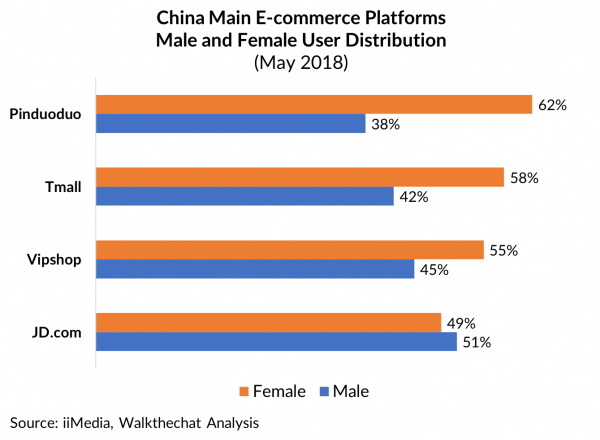Originally posted on WALK THE CHAT, written by Thomas Graziani
When talking about B2C platforms in China, Alibaba is usually the first name that comes to people’s minds. Seldom do people think of JD.com, the largest retailer in China aiming to compete with Amazon on a global scale.
While the middle class is expanding fast in China, Chinese consumers are paying more attention to the quality and authenticity of goods, oddly enough JD.com happens to be a company focused on customer experience and quality of their products. Will JD.com take the lead in China’s e-commerce in the future?
China’s B2C market
It is not news that China is under monopolies or oligopolies in numerous sectors and the B2C e-commerce market is one of them.
In Q4 2017, two companies accounted for more than 80% of the total B2C e-commerce market in China. Unsurprisingly they are Tmall and JD.com. Meanwhile, the third B2C platform only accounts for 4% of the total market share:
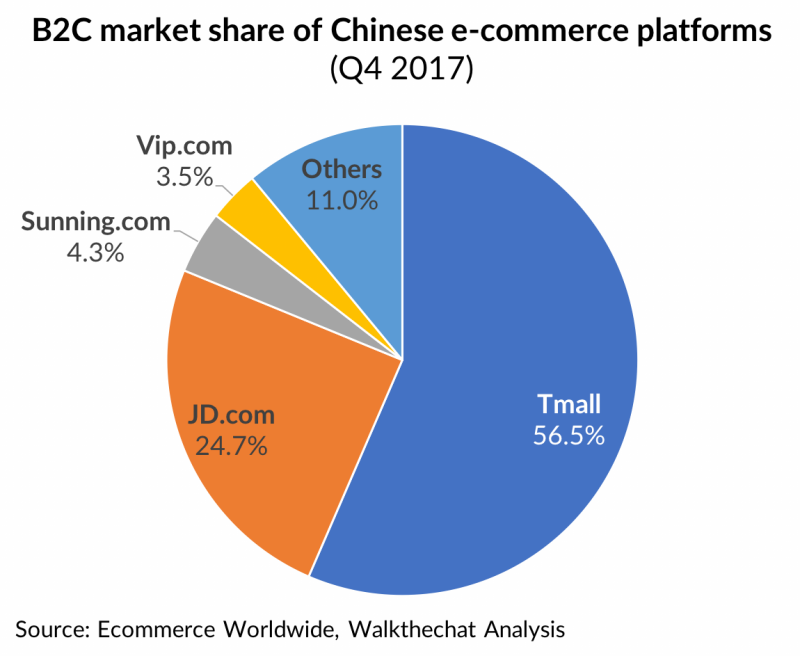
About JD.com
JD.com is China’s leading technology-driven e-commerce company, it is said to be China’s 4th largest e-commerce company right behind BAT; JD.com is a member of the NASDAQ 100 and a Fortune Global 500 company.
Financial figures
By looking at JD.com’s financial reports, the company appears to have been growing steadily. In 2017, JD.com’s revenue grew by 40% and the company got closer to profitability.
It’s net income/loss attributable to ordinary Shareholders however only reached a meager 116 million RMB (around US$16 million).
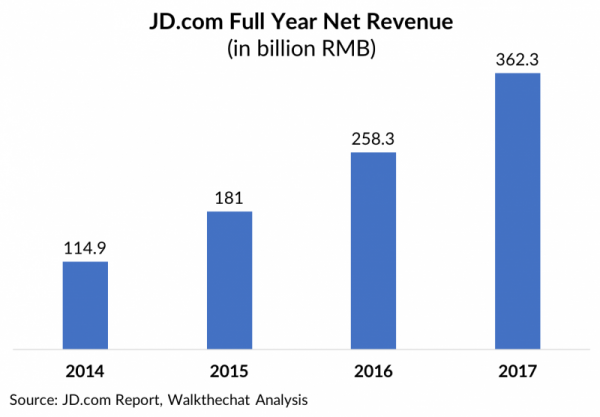
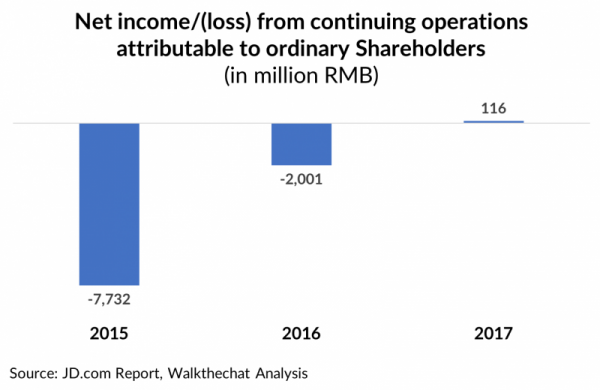
Despite Tmall being the largest B2C platform and the leading e-retailer by volume, JD.com is actually the number one leading e-retailer in Asia in terms of direct e-commerce sales (while Tmall/Taobao lead the way in terms of merchandise volume from third party vendors):
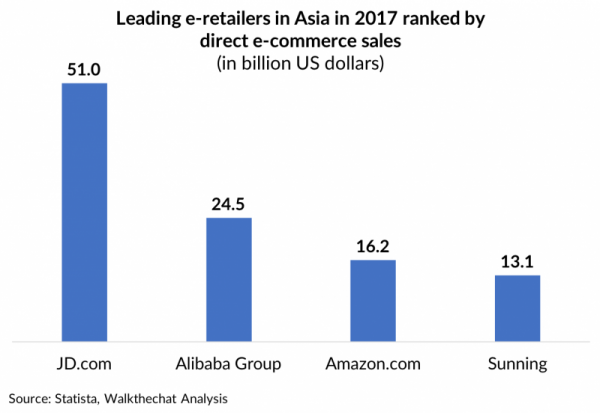
According to Counterpoint, JD.com has also been leading the market in terms of direct sales from mobile devices. In April 2018, the platform had 50% of direct mobile e-commerce sales market share which is twice the market share of its nearest rival Tmall.
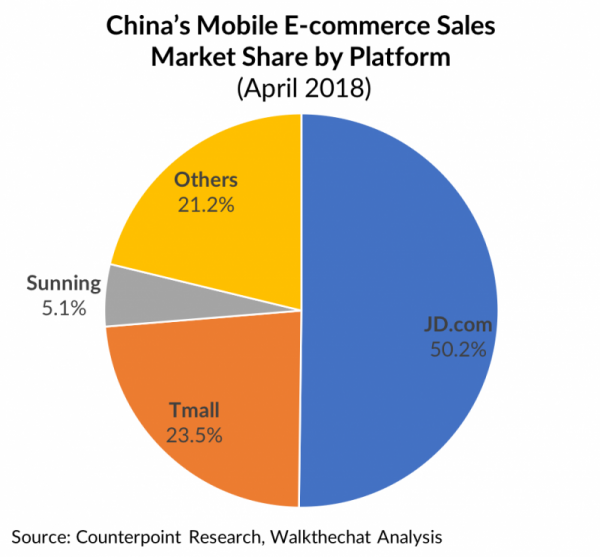
Furthermore, JD.com has been experiencing positive growth of annually active customer accounts since 2013 and the number of annual active customer accounts broke through 300 million already in the first quarter of 2018:

Therefore, even though Tmall is currently the single largest player, taking over 57% of the market share, JD.com has been posing an increasing threat to Tmall, especially in the mobile market.
JD.com’s strategy
Business model
JD.com differs itself from its largest competitor Tmall owned by Alibaba and the other B2C platform from its relatively mature in-house logistics leading to increased productivity and innovation across a range of industries.
JD.com’s business model is based on Richard Liu 4 layers inverted triangle:
- Basis: Team
- Supply chain: logistics, IT system and financial system
- Main KPI: Costs and efficiency
- Customer experience: product, price and service
JD.com’s ‘Asset-Heavy’ model vs. Alibaba’s ‘Asset-Light’ model
JD.com’s business model is inherently different from the B2C platforms we are familiar with. First, the company focuses on customer experience; the authenticity of its goods and speed of delivery are their secret to maximizing customers’ satisfaction.
In fact, JD.com is essentially a direct online retailer that buys and sells product, placing its emphasis on direct retail, in-house logistics and highly dedicated customer service operations, making it an asset-heavy business model.
Whereas Alibaba relies on an asset-light marketplace model, it is fundamentally an online platform for third-party sellers that focus on technology and third-party logistics partners to deliver goods to consumers. Tmall’s competitive advantage is its ability to offer customer of a safe-payment solution via Alibaba’s famous payment platform Alipay, and to provide its vendors with a strong infrastructure to support their operations.
JD.com positioning
According to JD.com’s customer profile report, the company has slightly more male users than female ones. While for Pinduoduo, Tamll and Vipshop, the number of female users is clearly dominating the number of male users.
JD.com delivery service
People that are familiar with JD.com would know that the company delivers most of their orders directly to customers themselves with 90% same-day or next-day delivery.
JD.com does so because it believes that it can gain more control and guarantee a better customer experience by doing everything in-house; it is with this belief that JD.com started investing in its in-house logistics, today, JD.com covers almost all counties and districts in China.
Let’s have a look at the impressive network that JD.com has built over the years:
- In 2017: JD.com had the aggregate gross floor area of approximately 5.6 million square meters in 54 cities
- In 2018 JD.com had 500 warehouses
- 6,906 delivery stations and pickup stations in 2,655 counties and districts across China
Investment in smart warehouses and new delivery methods
With the goal of having quicker deliveries at lower costs JD.com invested in smart warehouses and new delivery methods:
2014 – JD’s “Asia No.1” is the largest warehouse in China:
- This warehouse uses automated systems and various kinds of robots to deliver the products. In order to ensure the maximization of the efficiency of the system, the system sets priorities based on various metrics such as order values and demand of products.
- Only one employee is required in such warehouse to ensure the smooth operation of the system.
2017 – Drone delivery:
On June 18th, JD launched drone delivery experiment in Xi’an. The drones were able to deliver packages below 15kg in a circle with a radius of 8km.
Many other projects are being developed by JD.com: larger drones capable of carrying goods from 200kg to 1 ton in an area with a 500km radius, and Auto-delivery cars/robots that can carry around 5 pieces of packages and run 20km without recharging.
The drones are capable of making adjustments based on traffic and environmental conditions as well as detecting and avoiding obstacles.
Upon arrival at the target location, the robot would text the customer and wait for 30 minutes before going to the next destination. However, these auto-driving drones and cars remain at an experimental stage.
The borderless retail alliance
‘Our enemy’s enemy is our friend.’; JD.com is obviously familiar with this saying. Bearing in mind that Tmall is JD.com’s largest competitor, JD.com has successively partnered with two of the dominators of China’s tech scene, China’s largest search engine Baidu and the social media giant Tencent, also known as Alibaba’s number one competitor.
As early as 2014, JD.com has received the strategic investment from Tencent. Later, it also enlisted the help of Baidu and Vipshop, its e-commerce competitor, as part of its borderless retail alliance.
However, JD.com’s alliance does not stop here, as mentioned earlier, JD.com has the ambition to compete with Amazon on a global scale. In order to measure up, JD.com has to seek international partners.
JD.com global partnerships
Increased global influence
According to official statistics, JD.com’s foreign orders year-on-year growth increased by 375% this year.
In fact, JD.com has been speeding up its internationalization strategy since the beginning of the year. Richard Liu claimed that JD.com aims to create a globalized supply chain just a couple months ago. JD.com’s global expansion plan includes enlarging its Silicon Valley scope, preparing the company’s European R&D center and creating JD.com offices in NYC, Australia and Milan.
JD.com x Walmart
JD.com’s international strategy has started with its partnership with Walmart in 2016. JD.com bought Walmart’s online business Yihaodian in exchange for a 5% equity share in the company. This partnership allowed the largest offline retailer in the world to sell directly to Chinese consumers via China’s second-largest B2C platform.
As for JD.com, collaborating with Walmart is a strategic advantage: given to its last-mile delivery model, Walmart’s physical stores can serve JD.com as distribution centers; moreover, Walmart is a major supplier of JD.com’s O2O grocery delivery service JD Daojia.
On top of that, in the following years, Walmart will most likely play a key role in helping JD.com enter America, especially the US market.
JD.com x Google
On 28 June 2018, Google announced a $550 million investment in JD.com as part of a strategic partnership.
JD.com and Google will jointly develop new retail solutions around the globe.
By applying JD’s supply chain and logistics expertise and Google’s technology strengths, the two companies aim to explore the creation of next-generation retail infrastructure solutions, with the goal of offering helpful, personalized and frictionless shopping experiences.
JD also plans to sell its products through Google Shopping in multiple regions. Furthermore, Google’s large database will provide JD.com better insights into users’ buying behavior as well as advice JD.com on ad placement strategy, which will help JD.com compete with Alibaba.
In summary, this partnership will help JD.com accelerate its internationalization and improve its zero-border retail; as JD.com’s Chief Strategy Officer said, this cooperation ‘marks an important step in the process of modernizing global retails’.
Conclusion
JD.com chose to develop in-house logistics and take on inventory risks; which allow JD.com to have fast delivery times and authentic products, thus providing customers with a better experience. With all these assets plus partnerships and the increasing middle class in China endorsing JD.com, the company has the capability to challenge Alibaba, if not to outperform it.
As for the global retail market, JD.com has publicly stated its intentions to challenge Amazon for primacy in the US. Though JD.com has still not revealeda concrete strategy for this purpose, the company is left with quite a few options and leverages: not only its partnership with Walmart and Google can be put into great use, JD.com can also gain market share by sourcing goods at a lower price in China than Amazon which puts Amazon at a disadvantage.
Whatever happens, it remains clear that JD.com will continue to be a powerful force in global retail going forward.

